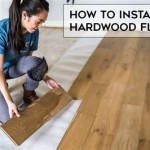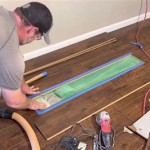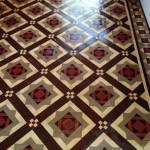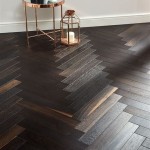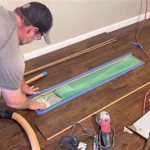How to Replace a Damaged Laminate Floor Board
Laminate flooring offers a durable and aesthetically pleasing alternative to hardwood, providing a resilient surface capable of withstanding daily wear and tear. However, even with its durability, laminate is susceptible to damage from impacts, spills, and excessive moisture. When a laminate floor board becomes damaged, whether chipped, scratched, stained, or warped, replacement is often the most effective solution to restore the floor’s appearance and prevent further deterioration. Replacing a single laminate board is a manageable DIY project, but it requires careful planning, the right tools, and a systematic approach. This article provides a step-by-step guide on how to replace a damaged laminate floor board, ensuring a seamless and long-lasting repair.
### Identifying the Damaged Board and Gathering Necessary MaterialsThe first step in replacing a laminate floor board is accurately identifying the specific board requiring replacement. Thoroughly inspect the floor to locate the damaged area and confirm that the damage is not superficial and requires a full board replacement. Surface scratches or minor stains may be resolved with specialized laminate repair kits or cleaning solutions, negating the need for a complete replacement. However, significant damage, such as deep gouges, swelling from water damage, or cracks that compromise the board's integrity, necessitates replacement.
Once the damaged board is identified, the next step is gathering the necessary materials. The essential materials include: a replacement laminate board, a tapping block, a pull bar, a hammer, a utility knife, safety glasses, work gloves, a measuring tape, a pencil, a jigsaw (or circular saw), and wood glue (optional, for added security in some installations). Ideally, the replacement board should be from the original flooring installation to ensure a perfect match in color, pattern, and thickness. If the original boards are unavailable, obtain a replacement board that closely resembles the existing flooring. It is advisable to purchase an extra board or two, in case of mistakes or future damage.
Prior to commencing the replacement process, it is crucial to gather the appropriate safety equipment. Safety glasses are vital to protect the eyes from flying debris generated during cutting and hammering. Work gloves will protect the hands from splinters and sharp edges. Proper ventilation is also essential, particularly when using adhesives or cutting tools. Ensure the workspace is well-lit to facilitate accurate cutting and fitting.
### Removing the Damaged Laminate BoardThe removal process depends on the location of the damaged board. If the board is located adjacent to a wall, the removal process is relatively straightforward. However, if the board is located in the middle of the floor, a more intricate approach is required. The following steps outline both scenarios:
Scenario 1: Board Adjacent to a Wall
Using a utility knife, carefully score the perimeter of the damaged board along the edges, where it meets the adjacent boards. This will help to prevent chipping and ensure a clean break. Next, use a pry bar or pull bar to gently lift the damaged board from the subfloor. Start at one corner and work around the edges, applying even pressure to avoid damaging the surrounding boards. If the board is glued to the subfloor, use a putty knife to loosen the adhesive. Once the board is free, remove it carefully, being mindful of any nails or staples that may be present.
Scenario 2: Board Located in the Middle of the Floor
This scenario requires a more invasive approach, as the damaged board is locked in place by surrounding boards. Start by using a utility knife to carefully score the perimeter of the damaged board, as described above. Next, carefully drill a hole in the center of the damaged board, large enough to accommodate the blade of a jigsaw. Insert the jigsaw blade into the hole and carefully cut along the scored lines, effectively dividing the damaged board into smaller, manageable pieces. Be cautious not to cut too deeply and damage the subfloor. Once the board is divided into pieces, use a pry bar or pull bar to carefully remove each piece, starting from the center and working outwards. This method allows for the removal of the damaged board without disturbing the surrounding boards' interlocking mechanisms.
Regardless of the removal method, once the damaged board is removed, thoroughly clean the subfloor. Remove any debris, dust, or adhesive residue. Ensure the subfloor is level and free from any imperfections that may affect the installation of the replacement board. A properly prepared subfloor is crucial for ensuring a stable and long-lasting repair.
### Installing the Replacement Laminate BoardBefore installing the replacement board, verify that it fits properly in the space left by the damaged board. Check the alignment and ensure that the interlocking edges align correctly with the surrounding boards. If necessary, trim the replacement board using a jigsaw or circular saw to ensure a perfect fit. Precision is crucial at this stage to achieve a seamless and professional-looking repair.
Laminate flooring typically features a tongue-and-groove locking system that allows the boards to interlock. Carefully align the replacement board with the adjacent boards, ensuring that the tongue and groove edges are properly aligned. Use a tapping block and hammer to gently tap the replacement board into place. The tapping block prevents damage to the edges of the board during the hammering process. Work around the perimeter of the board, applying even pressure to ensure a secure fit. Listen for a distinct "click" as the boards lock together.
In some cases, particularly when replacing boards in high-traffic areas or near seams, it may be beneficial to apply a small amount of wood glue to the interlocking edges for added security. Apply the glue sparingly, as excessive glue can make future repairs more difficult. Once the glue is applied, immediately wipe away any excess with a damp cloth. Allow the glue to dry completely according to the manufacturer's instructions before allowing foot traffic on the repaired area. This ensures a strong and durable bond between the replacement board and the surrounding flooring.
Once the replacement board is securely installed, inspect the repaired area for any gaps or misalignment. If any issues are detected, gently tap the board into place using the tapping block and hammer. Ensure that the replacement board is flush with the surrounding boards and that there are no noticeable height differences. A properly installed replacement board should blend seamlessly with the existing flooring, restoring the floor's appearance and functionality.
Finally, clean the repaired area thoroughly to remove any dust, debris, or adhesive residue. Use a damp cloth to wipe down the surface and allow it to dry completely. Avoid using harsh chemicals or abrasive cleaners, as these can damage the laminate flooring. Once the repaired area is clean and dry, it is ready for normal use.
Replacing a damaged laminate floor board is a manageable DIY project that can significantly enhance the appearance and longevity of the flooring. By following these detailed steps, homeowners can effectively repair damaged laminate boards and maintain the integrity of their floors.

Replace A Damaged Board In Laminate Floor Rw Supply Design

How To Fix A De Laminated Board Without Removing The

How To Replace Lock Vinyl Flooring

Replace A Damaged Board In Laminate Floor Rw Supply Design

How To Replace Warped Water Damaged Laminate Floor Boards

How To Replace A Damaged Laminate Board That S In The Middle Of Floor

How To Repair Damaged Laminate Floor Checkatrade

How To Replace A Floorboard Fine Homebuilding

How To Replace A Laminate Board In The Middle Without Dismantling Building Diy

How To Repair Laminate Flooring The Home
See Also

